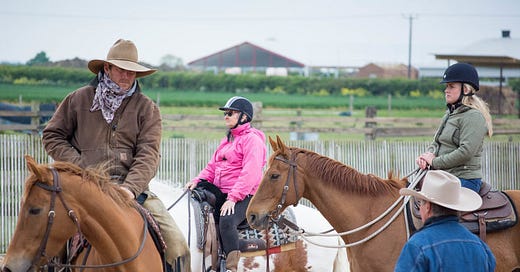Weathered hands resting lightly on the reins, moving perfectly with the horse, the horse responds to the slightest cue, pivoting on a dime to cut a cow from the herd. This isn't just good riding—it's a dance, a conversation, a partnership. This is Joe Wolter's brand of horsemanship.
From Ranch Hand to Horsemanship Icon
During Wolter's childhood on the family's ranch in Colorado, horses were not considered pets but working partners.
After graduating from high school, Wolter worked at various ranches. However, fate intervened at Soldier Meadows Ranch. The cow boss there was none other than Ray Hunt, a name that would later become synonymous with natural horsemanship.
"When I saw a guy ride in this way, a way that the horses looked happy at any speed, I was young, and I wanted to know how that worked, so the journey began," Wolter told me during an interview at his 2017 UK clinic tour.
The Triad of Horsemanship: Feel, Timing, and Balance
Wolter's approach to horsemanship emphasizes communication, understanding, and mutual respect rather than dominating the horse or enforcing rigid rules. Like that of many who teach natural horsemanship, his approach falls into three categories.
Feel: The ability to sense and respond to the horse's subtle cues and energy.
Timing: When to apply or release pressure to communicate effectively with the horse.
Balance: Maintaining physical and mental equilibrium, which in turn helps the horse find its own balance.
"Rider's need to be connected to the horse's feet, from the rider's hands to the horse's feet and then you will have his mind," Wolter explained during our interview. "It's ok to let horses move; if he's moving, then you can direct the motion."
Beyond the Ranch: Competing and Teaching
Wolter has been successful in competition, winning the inaugural AQHA Versatility Ranch Horse competition in 2002 at the Fort Worth Stock Show. But competing was never about the ribbons for Wolter.
"I enjoyed the learning portion but not the stress," he admitted. "I like setting goals and seeing if I can match them. Competing and having goals did make me a better rider."
Today, Wolter's schedule is dominated by clinics, where he shares his knowledge with eager students. I had the privilege of watching him work during his UK tour, where he held horsemanship and cow working clinics.
The Cow Work Conundrum
Watching the cow clinic, I could see that the participants loved it, but I still wondered, "Why teach cow work to riders who might never see a cow outside a field?"
"If their horse is insecure, it can help them find new ways to handle this. Cow work encourages you and your horse to problem-solve. Working a cow takes precision and timing; it will show how responsive your horse is to you."
It's not about becoming a ranch hand—it's about developing a deeper connection with your horse, improving your timing, and learning to think on your feet (or in the saddle, as it were).
The Wolter Way: Key Insights
Observation is Key: Wolter emphasizes the importance of watching horses interact with each other and their environment.
Patience and Consistency: Wolter encourages riders to give their horses the time needed to understand and respond to cues.
Adaptability in Training: Every horse is unique. What works for one might not work for another. Flexibility is the name of the game.
The Mental Game: A calm and focused mind is essential for effective horse communication, and it's not just about what you do—it's about how you think.
Let it Happen: "People who do make the change will be because they worked for it and are also the people who can let things happen rather than make them happen," Wolter notes. It's about guiding, not forcing.
The Legacy Continues
Joe Wolter's influence extends far beyond the arena or the ranch. Through his clinics, articles, and mentorship, he's shaping the future of horsemanship. He remains committed to ongoing learning and development, setting an example for lifelong learning.
As we concluded our interview, Wolter shared a final thought that captures his approach: "Conversing with a horse involves being aware and allowing the horse to figure things out."
Joe Wolter reminds us that true horsemanship is a journey of mutual understanding, respect, and continuous growth.
So, take a moment the next time you're in the saddle. Feel your horse beneath you. Listen to what they're telling you. You're having a conversation. Make it a good one.






